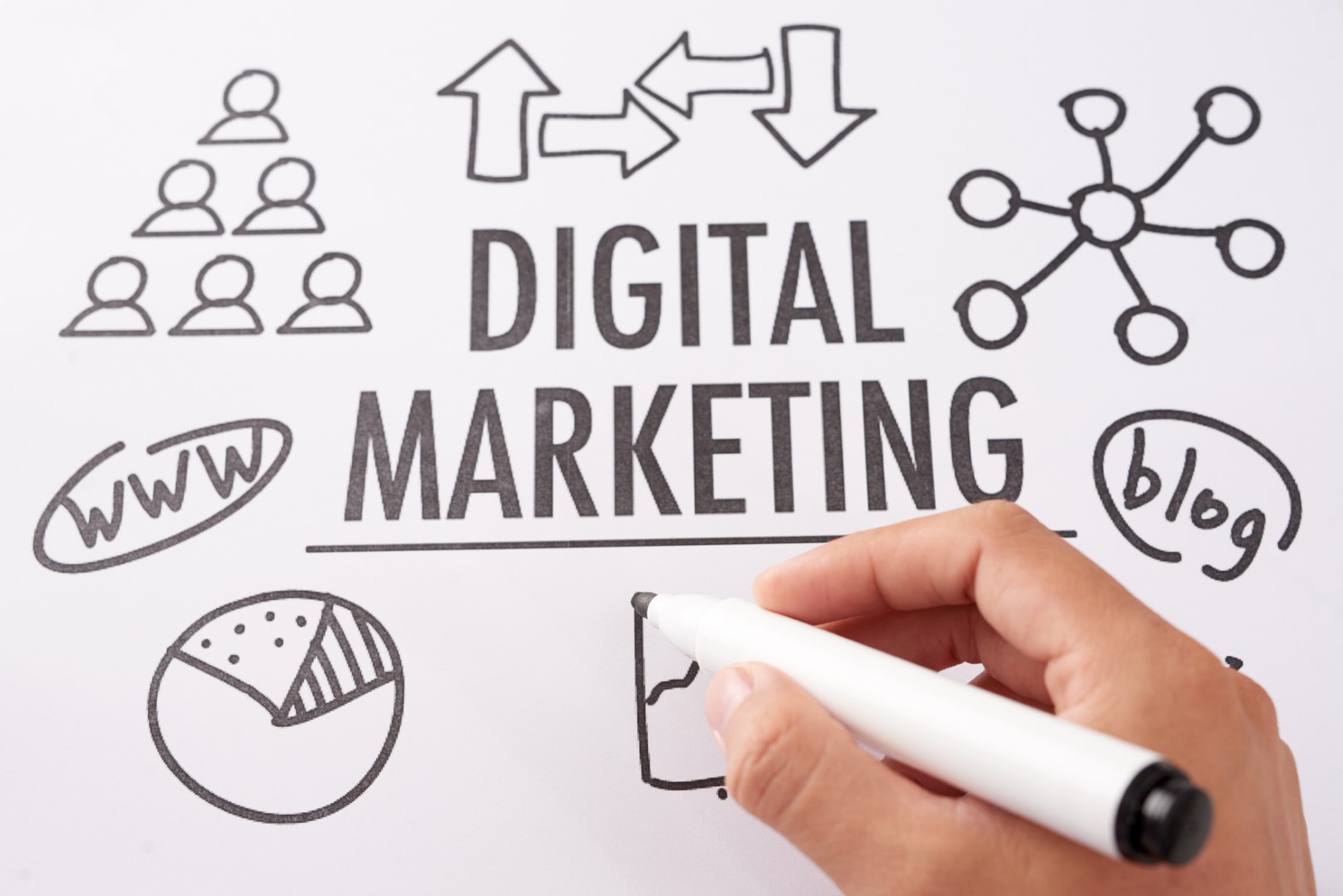Businesses must adapt to the evolving marketing landscape to stay competitive and effectively reach their target audiences. Digital marketing encompasses various strategies and techniques that leverage the internet and digital channels to promote products, services, and brands. This comprehensive approach includes optimizing web content, creating valuable and relevant materials, leveraging social media platforms, and utilizing paid advertising to increase visibility. By employing these methods, businesses can enhance their online presence, drive traffic, and convert visitors into loyal customers. Integrating these strategies enables companies to establish a strong digital presence that fosters growth and success. Let’s explore the fundamentals of digital marketing, providing a thorough understanding of its core components and best practices.
What Is Digital Marketing?
Digital marketing involves advertising products or services using online digital technologies, such as mobile phones, display advertising, and other digital mediums.. It involves a wide range of marketing activities, from content creation and social media management to search engine optimization (SEO) and email marketing. The primary goal of digital marketing is to connect with potential customers and convert them into loyal clients. Businesses can refine their strategies and achieve better results by leveraging analytics and data management. Effective digital marketing ensures a strong online presence and sustained growth.
The Role of Digital Marketing Companies
Digital marketing companies play a crucial role in helping businesses navigate the complexities of online marketing. They offer expertise in creating cohesive and effective online marketing strategies, ensuring businesses can efficiently reach their target audience. By leveraging advanced analytics and staying updated with industry trends, these companies fine-tune campaigns to achieve optimal results. Their knowledge of the latest technological advancements allows businesses to remain competitive in an ever-evolving market. Ultimately, digital marketing companies drive engagement and foster growth, enabling businesses to thrive online.
Key Components of Digital Marketing
The key components of digital marketing encompass a variety of strategies designed to optimize web content, create engaging materials, leverage social media platforms, and utilize paid advertising to increase visibility. Each component plays a vital role in creating a comprehensive and effective digital marketing strategy, working together to enhance online presence, drive traffic, and convert visitors into loyal customers.
Search Engine Optimization (SEO)
SEO is the process of optimizing a website to rank higher in search engine results pages (SERPs), thereby increasing organic (non-paid) traffic. It involves several techniques and practices to improve website’s visibility on search engines like Google, Bing, and Yahoo. Effective SEO strategies include keyword research, on-page optimization, and creating high-quality content that meets the needs of users and search engines alike. Ultimately, SEO is an ongoing process that requires consistent effort and adaptation to stay ahead of competitors and maintain strong search engine visibility.
Digital Marketing On-Page and Off-Page SEO
On-page SEO focuses on optimizing individual web pages to rank higher and earn more relevant traffic in search engines. This optimization includes keyword research, content optimization, meta tags, URL structure, and internal linking. Off-page SEO involves activities conducted outside the website to improve its authority and reputation, such as backlink building, social signals, and brand mentions.
Content Marketing
Content marketing is the creation and distribution of valuable, relevant content to attract and engage a target audience. The goal is to drive profitable customer action by providing informative and entertaining content that addresses their needs and interests. This approach builds trust and credibility with potential customers and fosters long-term relationships that can lead to increased loyalty and repeat business. By consistently delivering high-quality content, businesses can position themselves as industry leaders and keep their audience engaged and informed.
Content Types and Strategy for Digital Marketing
Content can take many forms, including blog posts, videos, infographics, ebooks, whitepapers, and social media posts. A successful content marketing strategy involves audience research, content planning, choosing distribution channels, and performance measurement.

Social Media Marketing
Social media marketing leverages social media platforms to promote products, services, and brands. It involves creating and sharing content on social networks to achieve marketing and branding goals. Through targeted campaigns, businesses can engage with their audience, build brand awareness, and foster customer loyalty. Additionally, social media marketing allows for real-time interaction and feedback, enabling companies to quickly adapt their strategies based on customer responses and trends.
Social Media Platforms and Strategy Used for Digital Marketing
Popular social media platforms include Facebook, Instagram, Twitter, LinkedIn, and Pinterest. An effective social media strategy involves content creation, community management, advertising, and analytics to monitor performance metrics like reach, engagement, and follower growth.
Pay-Per-Click (PPC) Advertising
PPC advertising is a model where advertisers pay a fee each time their ad is clicked. It allows businesses to buy visits to their site rather than earning them organically. This approach ensures immediate visibility and can drive targeted traffic to a website. Google Ads is the most popular PPC platform, but others include Bing Ads, Facebook Ads, and LinkedIn Ads, each offering unique advantages for reaching specific audiences.
Key Elements of PPC Advertising and Digital Marketing
The key elements of a successful PPC campaign include keyword research, ad copy, landing pages, bid management, and performance tracking. These elements work together to maximize ad performance within budget constraints and achieve desired outcomes.
Email Marketing
Email marketing involves sending targeted emails to prospects and customers to nurture relationships and drive conversions. It is a cost-effective way to reach a large audience and deliver personalized messages. Businesses can tailor their content to specific groups by segmenting email lists and increasing engagement and response rates. Additionally, email marketing provides valuable insights through metrics like open and click-through rates, helping businesses refine their strategies and improve effectiveness.
Email Marketing Strategy in Digital Marketing
A robust email marketing strategy includes list building, segmentation, content creation, automation, and analytics. These components help deliver relevant content to the right audience at the right time, optimizing the chances of conversion.
Affiliate Marketing
Affiliate marketing is a performance-based marketing strategy where businesses reward affiliates (partners) for driving traffic or sales through their marketing efforts. Affiliates promote products or services using unique tracking links and earn a commission for each conversion. This approach allows businesses to expand their reach and generate sales without upfront advertising costs. By leveraging the efforts of affiliates, companies can effectively tap into new markets and customer segments.
Key Components of Affiliate Marketing
Key components of affiliate marketing include affiliate networks, recruitment, commission structures, tracking and reporting, and compliance. These elements ensure that affiliates effectively promote products and generate sales while adhering to the brand’s guidelines.
Influencer Marketing
Influencer marketing involves partnering with individuals who have a significant following and influence over a target audience. Influencers promote products or services through their content, leveraging their credibility and reach. This strategy helps businesses tap into the influencer’s established audience, increasing brand awareness and trust. By collaborating with influencers, companies can effectively engage with potential customers in a more authentic and relatable manner.
Influencer Types and Strategy in Digital Marketing
Influencers can be categorized into macro-influencers, micro-influencers, and nano-influencers based on their follower count and engagement levels. An effective influencer marketing strategy involves identifying the right influencers, building partnerships, creating engaging content, and measuring performance.
Digital Marketing Analytics and Data Management
Data is the backbone of digital marketing, providing essential insights into customer behavior and campaign effectiveness. Analytics tools help businesses measure the performance of their marketing efforts and make data-driven decisions. By analyzing metrics such as website traffic, conversion rates, and user engagement, companies can refine their strategies for better results. This continuous feedback loop allows for constant optimization, ensuring marketing initiatives remain effective and aligned with business goals.
Metrics and Tools Used By Digital Marketers
Key metrics include traffic, engagement, conversions, and ROI. Analytics tools like Google Analytics, social media analytics, email marketing analytics, and PPC analytics provide insights into these metrics, helping businesses optimize their strategies.

Developing a Digital Marketing Strategy
Creating a successful digital marketing strategy involves several steps. It begins with setting clear, measurable goals for marketing efforts. Audience research follows, aimed at understanding the target audience’s demographics, behavior, and preferences. Competitive analysis helps identify opportunities and threats by analyzing competitors’ strategies. Once these steps are completed, businesses can develop and implement tailored marketing campaigns to effectively reach and engage their target audience.
Execution and Optimization of Your Digital Marketing Strategy
After planning, the strategy is implemented by creating and distributing content, running ads, and engaging with the audience. Continuous measurement and optimization are crucial, as well as using performance metrics to refine and improve the strategy over time.
Understanding the Fundamentals of Digital Marketing
Digital marketing is an ever-evolving field that requires businesses to stay agile and adapt to new trends and technologies. Artificial intelligence, machine learning, and automation will play increasingly significant roles in digital marketing. Personalization, data privacy, and omnichannel marketing will also become more critical as consumers’ expectations and behaviors evolve.
By understanding and implementing the fundamentals of digital marketing, businesses can create effective strategies that drive growth, engagement, and conversions. Staying updated with the latest trends and technologies will ensure continued success in the dynamic digital landscape.
Check out our BrandRep blog to learn more about paid advertising, website builds, and reputation management services for your business.










